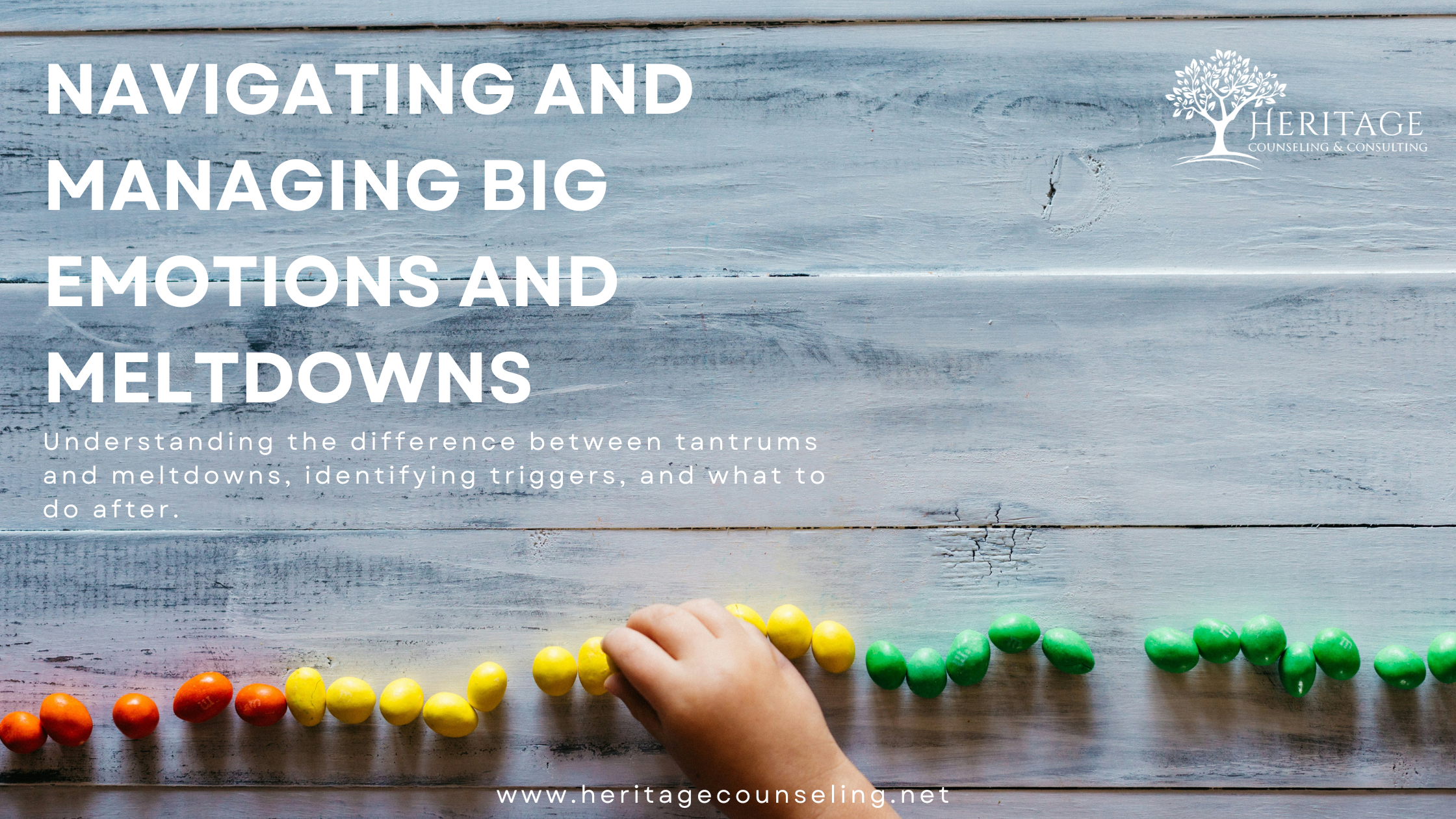Emotional regulation during childhood represents a fundamental aspect of healthy development, one that is often pivotal in navigating the challenges of childhood meltdowns. Unlike tantrums that children may employ to express dissatisfaction or to achieve a specific outcome, meltdowns signal an intense response to overwhelming situations, creating a temporary loss of behavioral control. This distinction is critical in understanding the complex landscape of big emotions children experience and effectively managing the behavioral responses that follow.
Acknowledging the significance of emotional regulation in childhood, this piece aims to equip caregivers with tools to process big emotions, address tantrums and meltdowns, and implement both preventative and post-meltdown coping mechanisms. By doing so, caregivers can foster a supportive environment conducive to navigating their child’s emotional needs.
Understanding the Root of Tantrums and Meltdowns
Understanding the diverse nature of big emotions involves recognizing the range of factors influencing emotional regulation and expression. These factors range from developmental stages to individual differences in temperament and sensitivity.
Developmental Influences: The prefrontal cortex, crucial for emotion regulation, is underdeveloped in children, making it difficult for them to control behaviors when emotions are intense. This area of the brain does not fully mature until the early 20s, contributing to the challenge of managing big emotions during childhood and adolescence.
Individual Temperament and Sensitivity: Every child's response to their environment is unique, with some children being highly sensitive and experiencing emotions more intensely. Recognizing and respecting these individual differences is essential in understanding each child's emotional foundation.
External Factors and Triggers: Big emotions can be triggered by stress, hunger, tiredness, overstimulation, and changes in family structure or environment. Emotional meltdowns may occur when children encounter overwhelming situations and lack the verbal ability or coping mechanisms to express themselves effectively. Significant life changes and traumatic experiences also play a vital role in emotional meltdowns.
Understanding Big Emotions in Children
Children’s emotional landscapes are complex and varied, requiring nuanced understanding and support from caregivers. Central to navigating these big emotions is recognizing their roots and manifestations.
Anger, Sadness, Anxiety: While often overwhelming, these emotions are a natural part of children’s emotional development. Unexpressed or suppressed emotions can significantly influence behavior, making it crucial for caregivers to validate and normalize these feelings.
Physical Sensations: Emotions are not just mental states but can also create physical sensations in the body. Helping children recognize these sensations can foster a deeper understanding of their feelings.
Emotional Vocabulary: Assisting children in developing a vocabulary to describe their feelings is essential. This includes acknowledging emotions, showing empathy, and refraining from immediately fixing or stopping the emotion.
Modeling and Coaching: Caregivers can model healthy emotional expression and regulation, providing a safe space for children to explore and experiment with their responses. Mindfulness and exposure to manageable stress can also strengthen emotional regulation skills.
Understanding and managing big emotions in children is not only important for their immediate well-being but also lays the foundation for healthy emotional regulation skills in adulthood.
Understanding The Difference Between Tantrums and Meltdowns
Tantrums
Triggers and Responses: Often a reaction to not getting what they want, childhood tantrums are often triggered by fear, frustration, anger, or sensory overload. They may involve crying, yelling, or stomping, but are generally a method for seeking attention or a specific outcome.
Control and Duration: Children can exert some control over tantrums. They may stop once they achieve what they want or realize they will not get it through this behavior.
Management Approach: Acknowledging the child’s desires without yielding and encouraging more effective communication methods are key. Caregivers should ignore tantrums while ensuring safety and teach more appropriate ways to communicate needs.
Meltdowns
Triggers and Responses: Triggered by overwhelming situations such as sensory differences, unexpected changes, or communication difficulties, meltdowns represent a loss of control, often resulting in intense emotional and physical responses. Unlike tantrums, meltdowns are not aimed at achieving a specific outcome but are a reaction to feeling overwhelmed.
Control and Duration: Characterized by a loss of control, meltdowns can last longer and are more intense. They end not when a desire is met, but typically when the child becomes too exhausted to continue or the overwhelming situation changes.
Management Approach: Requiring a different approach, caregivers should focus on removing the child from the overwhelming situation and helping them find a quiet place to calm down. Over time, it is crucial to assist the child in developing strategies to better manage anxiety-provoking situations where sensory overload can occur.
Identifying Triggers and Preventative Measures
Identifying triggers is the first step in managing meltdowns effectively. Common triggers include specific times of the day like homework or bedtime, transitions between activities, and sensory overstimulation. Recognizing triggers allows for strategic planning to either avoid them or manage them more effectively.
Trigger Journal: Keeping a journal can help identify patterns and triggers leading to meltdowns, facilitating management and prevention efforts.
Sensory Equipment: Use sensory tools or strategies to help regulate sensory input, creating a low-arousal environment that minimizes potential triggers.
Positive Reinforcement: Give plenty of positive attention and acknowledge good behavior to encourage more of the same.
Routine and Predictability: Establish consistent, predictable routines. Changes in routine can be distressing and lead to meltdowns.
Model Behavior: Caregivers should be clear about behavioral expectations, model calm behavior, take time-outs when angry, and teach self-soothing techniques like belly breathing, grounding, and progressive muscle relaxation.
By understanding and addressing triggers, caregivers can create a supportive environment that reduces the incidence of emotional meltdowns, fostering healthier emotional regulation in children.
Coping Mechanisms During a Tantrum or Meltdown
When navigating through the turbulent waters of emotional meltdowns and tantrums, caregivers can adopt a variety of strategies tailored to soothe and support the child. These strategies emphasize the importance of calmness, understanding, and proactive measures to manage intense emotions effectively.
During Tantrums:
Ignore non-dangerous behaviors to avoid reinforcing them with attention.
Model calmness and stay composed. Do not escalate the situation with frustration, taking a time-out if needed.
Offer comfort for basic needs like hunger or tiredness.
Avoid engaging in a power struggle or overwhelming the child with questions/responses.
During Meltdowns:
Recognize early signs of agitation to intervene before escalation.
Guide the child to a quieter, safer space to minimize sensory overload.
Use calming devices, distractions, or sensory items. Implement grounding techniques and breathwork like the 5, 5, 5 method to bring focus to the present.
Modify the environment to reduce discomfort and provide structured choices.
Long-Term Coping Strategies:
Adopt stress-reducing routines such as exercise, meditation, laughter, and appropriate physical touch.
Build an emotional toolkit with the child for them to use when experiencing big emotions. Emotional toolkits often include calming items such as markers, coloring books, journals, slimes, playdoh, favorite scents, puzzles, soft blankets/stuffed animals, fidget toys, bouncy balls, and a feelings wheel.
Seek professional help if meltdowns are frequent, severe, or alarming to develop tailored coping strategies and support.
When practiced consistently, these coping mechanisms can significantly mitigate the intensity and frequency of emotional meltdowns, further supporting a nurturing environment for both the child and the caregiver.
Post-Meltdown Strategies
After an emotional meltdown, it is essential to focus on recovery, communication, and connection.
Allow Recovery Time: Give the child time to regroup and regain control without pressure.
Open Communication: Once calm, discuss what happened in a non-judgmental way. Focus on reflecting on feelings, understanding triggers, and exploring alternative ways to express frustration in the future. If inappropriate behavior occurs during the meltdown, an apology can help mend the relationship.
Praise Regained Control: Acknowledge the child’s effort in regaining control, reinforcing the importance of self-regulation.
Maintain Routines: Communicate and follow through with the child’s routine to reinforce predictability. Ensure the child gets adequate sleep and nutrition to help reduce the likelihood of future tantrums.
Signs Your Child May Benefit from Counseling
Managing big emotions is a multifaceted endeavor that requires patience, understanding, and consistent effort. To promote emotional resilience, caregivers are encouraged to model healthy emotional identification and expression, teach coping strategies to help children self-regulate, and seek professional assistance when appropriate. Some signs and behaviors that your child may benefit from professional help include:
Persistent or extreme difficulty regulating emotions despite parental efforts.
Behavioral changes impacting daily functioning and relationships.
Trauma or significant life changes affecting emotional well-being.
Withdrawal or avoidance of social situations.
Recurrent meltdowns interfering with academic performance or peer interactions.
Understanding and acting on these signs can significantly aid in supporting your child's emotional health and development.
Conclusion
Through the exploration of childhood emotional regulation, it becomes evident how imperative it is for caregivers to adeptly navigate big emotions and meltdowns in children. Understanding the roots of meltdowns and equipping caregivers with effective tools for emotional management is crucial in fostering a nurturing environment. Aiming to support the emotional development and well-being of children, this piece emphasizes the importance of early intervention and the positive impact of supporting emotional intelligence from a young age.
While the strategies outlined above offer a solid foundation for managing big emotions and meltdowns, some situations may require professional intervention. If you find persistent or extreme difficulties in navigating your child’s emotional needs or believe your child’s daily functioning is being impacted by their inability to emotionally regulate, please contact Heritage Counseling & Consulting at 214-363-2345 for professional support. Heritage has offices located in Dallas, Plano, and Austin and offers a wide range of services including play therapy (recommended for ages 4+), adolescent therapy, family therapy, and parenting services.
Sources:
https://www.positiveparentingsolutions.com/parenting/public-tantrums
https://childmind.org/article/how-to-handle-tantrums-and-meltdowns/
https://childmind.org/article/why-do-kids-have-tantrums-and-meltdowns/
https://www.understood.org/en/articles/taming-tantrums-vs-managing-meltdowns

